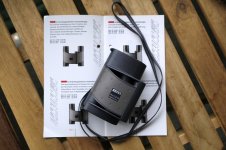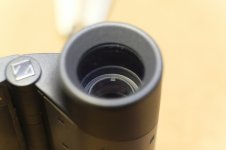Ignatius
Inactive member

DesignSelection 4x12 (1992-2000)

Specifications
This is an almost complete package. The integrated strap is in perfect condition, as is the clever plastic case. Solely the little manual is missing.
When I mentioned this purchase online and asked for further information, @jan van daalen popped an original mini brochure from March 1995 in pristine condition in the mail to me. Fantastic! Thank you Jan!
The little binocular is the gandfather of today’s Victory pocket line.
The body is made of some composite material (dare I call it ‘plastic’?) with the grey inset having a hard-rubbery feel to it. The tiny square indentations are more of a design thing than an aid to secure gripping. Then again this bino is so light that it is unlikely to slip out of your hands. And since it is not waterproof either, it is unlikely to be used in wet weather. The eyecups are classic rubber fold-down ones and the diopter adjustment is on the right ocular.
Ca. 1992 4x12 B T*P* and 2021 Victory Pocket 8x25




As one can see in the following images, the focus is not a proper internal one: behind those protective glasses, the objective lenses move forwards and backwards.
At close focus:

At infinity:

So far so good. What’s it like to look through?
Despite its small size it has a 3 mm exit pupil and a measured eye relief of 11 mm. Together with an eyecup od of 30 mm and an ocular lens diameter of 12 mm this makes for a surprisingly good Einblickverhalten. Aligning my pupils with the optical axis is easy and I can rest the eyecups in my usual spot – against the underside of my eyebrows (supraorbital margin?).
The T*P* coatings do indeed produce a bright and sharp image and the sweet spot is around 70%. After that things get a little fuzzy. This, however, is easily remedied with a touch of the focusser. Talking of which: the focusser is smaller than that of the descendant, the Victory Pocket, both in diameter (15 mm vs 19.5 mm) and depth (7 mm vs 13.5 mm). The 4x focusser is of the same plastic as the body while that of today’s VP 8x25 is covered in hard rubber. The action of the 4x focusser is just as smooth as the modern one, but because of the material choice it is not so good when wearing gloves.
To my eyes there is no colour bias. I could not detect any rolling ball (barrel distortion) when panning. If anything, there might have been a miniscule tendency to pincushion distortion. Due to the current grey skies I have not been able to test for CA or glare.
As a 4x it has excellent depth of field, and once set to about 20 m is in focus to infinity.
At 12 mm objective diameter this will never be a light monster but it certainly has its uses.
I have taken it out on dog walks and although it would be all but useless in that wonderful American (South) West, that fabulous Big Country with the Open Skies, here in Europe, where the fields are smaller and there are always numerous hedges and copses and windbreaks, 4x is not nearly as useless as marketing dudes, salespeople or cleverclogs would have us believe.
And I can see some other, as yet untested by me, uses: city trips, museums, opera/theatre or even art galleries. The little @Zeiss brochure puts it thus:
”The most attractive fusion of form, function and performance. Foldable to a tiny, easily carried package. With a field of view of 184 m it is ideal for events, the theatre, museums, art galeries, sports meetings.”
That whole pocket binocular series was available in three colourways: black, dark grey and the dark grey/light grey duo-tone which I have, and other configurations were 6x18 B, 8x20 B, 10x25 B.
The plastic case has black velvet glued into the ends to prevent dust from settling on the ocular and objective lenses when it contains the binocular. It looks as though the case is made from the same material as the binocular body.

No, I will probably not be able to count the hairs on Senor Diabolito’s ballsack at a hundred paces with this little tool due to the low resolution of those 12 mm objectives, but the other day I took it out on the lunchtime walk and happily spent some time watching a few ducks and a great egret at an estimated 100 m (note to self: it really is time to get a range meter).
It is commonly accepted that a 50 mm lens on a full-frame camera gives a view like the human eye. Well, if your Mk Is are like a 50 mm lens, then this tiny bino will upgrade them to a 200 mm tele. In my book that is not to be sneezed at.

Specifications
| Magnification | 4x |
| Objective Ø, mm | 12 |
| EP, mm | 3.0 |
| ER, mm | 11 (measured) |
| Twilight factor | 6.9 |
| Relative brightness | 9.0 |
| Transmission | (acc. to Zeiss) |
| Close focus, m | 1.0 |
| FOV, m/1000m | 184 |
| FOV ° | 10.43 |
| AFOV ° (ISO 14132-1:2002 standard) | 40.11 |
| Prism system | Schmidt-Péchan |
| Weight, g | 175 |
| Height, eyecups up, mm | 100 |
| Width, @ 65 mm IPD, mm | 93 |
| Year | still waiting for definitive answer from Zeiss (West Germany) |
This is an almost complete package. The integrated strap is in perfect condition, as is the clever plastic case. Solely the little manual is missing.
When I mentioned this purchase online and asked for further information, @jan van daalen popped an original mini brochure from March 1995 in pristine condition in the mail to me. Fantastic! Thank you Jan!
The little binocular is the gandfather of today’s Victory pocket line.
The body is made of some composite material (dare I call it ‘plastic’?) with the grey inset having a hard-rubbery feel to it. The tiny square indentations are more of a design thing than an aid to secure gripping. Then again this bino is so light that it is unlikely to slip out of your hands. And since it is not waterproof either, it is unlikely to be used in wet weather. The eyecups are classic rubber fold-down ones and the diopter adjustment is on the right ocular.
Ca. 1992 4x12 B T*P* and 2021 Victory Pocket 8x25




As one can see in the following images, the focus is not a proper internal one: behind those protective glasses, the objective lenses move forwards and backwards.
At close focus:

At infinity:

So far so good. What’s it like to look through?
Despite its small size it has a 3 mm exit pupil and a measured eye relief of 11 mm. Together with an eyecup od of 30 mm and an ocular lens diameter of 12 mm this makes for a surprisingly good Einblickverhalten. Aligning my pupils with the optical axis is easy and I can rest the eyecups in my usual spot – against the underside of my eyebrows (supraorbital margin?).
The T*P* coatings do indeed produce a bright and sharp image and the sweet spot is around 70%. After that things get a little fuzzy. This, however, is easily remedied with a touch of the focusser. Talking of which: the focusser is smaller than that of the descendant, the Victory Pocket, both in diameter (15 mm vs 19.5 mm) and depth (7 mm vs 13.5 mm). The 4x focusser is of the same plastic as the body while that of today’s VP 8x25 is covered in hard rubber. The action of the 4x focusser is just as smooth as the modern one, but because of the material choice it is not so good when wearing gloves.
To my eyes there is no colour bias. I could not detect any rolling ball (barrel distortion) when panning. If anything, there might have been a miniscule tendency to pincushion distortion. Due to the current grey skies I have not been able to test for CA or glare.
As a 4x it has excellent depth of field, and once set to about 20 m is in focus to infinity.
At 12 mm objective diameter this will never be a light monster but it certainly has its uses.
I have taken it out on dog walks and although it would be all but useless in that wonderful American (South) West, that fabulous Big Country with the Open Skies, here in Europe, where the fields are smaller and there are always numerous hedges and copses and windbreaks, 4x is not nearly as useless as marketing dudes, salespeople or cleverclogs would have us believe.
And I can see some other, as yet untested by me, uses: city trips, museums, opera/theatre or even art galleries. The little @Zeiss brochure puts it thus:
”The most attractive fusion of form, function and performance. Foldable to a tiny, easily carried package. With a field of view of 184 m it is ideal for events, the theatre, museums, art galeries, sports meetings.”
That whole pocket binocular series was available in three colourways: black, dark grey and the dark grey/light grey duo-tone which I have, and other configurations were 6x18 B, 8x20 B, 10x25 B.
The plastic case has black velvet glued into the ends to prevent dust from settling on the ocular and objective lenses when it contains the binocular. It looks as though the case is made from the same material as the binocular body.

No, I will probably not be able to count the hairs on Senor Diabolito’s ballsack at a hundred paces with this little tool due to the low resolution of those 12 mm objectives, but the other day I took it out on the lunchtime walk and happily spent some time watching a few ducks and a great egret at an estimated 100 m (note to self: it really is time to get a range meter).
It is commonly accepted that a 50 mm lens on a full-frame camera gives a view like the human eye. Well, if your Mk Is are like a 50 mm lens, then this tiny bino will upgrade them to a 200 mm tele. In my book that is not to be sneezed at.







